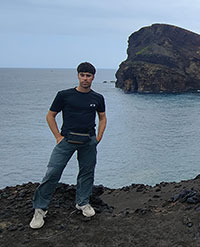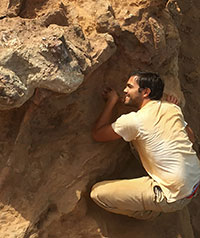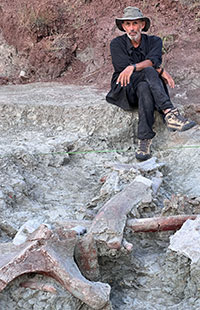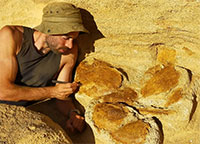 A. Cabezuelo-Hernández. Grupo de Biología Evolutiva, Departamento de Física Matemática y de Fluidos. Facultad de Ciencias, Universidad Nacional de Educación a Distancia(UNED), Avda. Esparta s/n, 28232. Las Rozas. Madrid, Spain.(Corresponding author) paleo.alb@gmail.com ORCID iD: 0000-0002-2990-8384
A. Cabezuelo-Hernández. Grupo de Biología Evolutiva, Departamento de Física Matemática y de Fluidos. Facultad de Ciencias, Universidad Nacional de Educación a Distancia(UNED), Avda. Esparta s/n, 28232. Las Rozas. Madrid, Spain.(Corresponding author) paleo.alb@gmail.com ORCID iD: 0000-0002-2990-8384
Alberto Cabezuelo Hernández is a PHD student at the Evolutionary Biology Group of the National University of Distance Education (UNED, Madrid, Spain) under the supervision of Dr. Adán Pérez García and Dr. Carlos de Miguel Chaves. He is currently studying the paleobiology of the Spanish Triassic eosauropterygian Paludidraco multidentatus (Simosauridae) and other simosaurids in the fossil record as part of his PHD Thesis. Additionally, he is interested in macroevolutionary and biomechanical patterns in Sauropterygia.
![]()
 C. De Miguel Chaves. Grupo de Biología Evolutiva, Departamento de Física Matemática y de Fluidos. Facultad de Ciencias, Universidad Nacional de Educación a Distancia(UNED), Avda. Esparta s/n, 28232. Las Rozas. Madrid, Spain. carlosmiguelchaves@gmail.com ORCID iD: 0000-0002-4002-9540
C. De Miguel Chaves. Grupo de Biología Evolutiva, Departamento de Física Matemática y de Fluidos. Facultad de Ciencias, Universidad Nacional de Educación a Distancia(UNED), Avda. Esparta s/n, 28232. Las Rozas. Madrid, Spain. carlosmiguelchaves@gmail.com ORCID iD: 0000-0002-4002-9540
Carlos de Miguel Chaves is a biologist who completed his PhD in Paleontology at the Evolutionary Group of the National University of Distance Education (Madrid, Spain), with whom he currently collaborates. His field of research is focused on Triassic marine reptiles from the Iberian Peninsula, especially placodonts, nothosaurs and simosaurs; this led him to the description of the taxa Paludidraco multidentatus and Parahenodus atancensis during his PhD back in 2018. He has attended numerous excavation campaigns in Spain and Portugal, and has worked as field technician at the Miocene fossil site of Can Mata (Barcelona, Spain). He is also dedicated to science communication, collaborating on podcasts, blogs, children's books and magazines, both with texts and illustrations.
![]()
 F. Ortega. Grupo de Biología Evolutiva, Departamento de Física Matemática y de Fluidos. Facultad de Ciencias, Universidad Nacional de Educación a Distancia(UNED), Avda. Esparta s/n, 28232. Las Rozas. Madrid, Spain. fortega@ccia.uned.es ORCID iD: 0000-0002-7431-354X
F. Ortega. Grupo de Biología Evolutiva, Departamento de Física Matemática y de Fluidos. Facultad de Ciencias, Universidad Nacional de Educación a Distancia(UNED), Avda. Esparta s/n, 28232. Las Rozas. Madrid, Spain. fortega@ccia.uned.es ORCID iD: 0000-0002-7431-354X
Francisco Ortega is a PhD in Biology (Paleontology) and a Professor at the Faculty of Sciences of UNED (Madrid), where he teaches subjects related to biodiversity to Environmental Sciences students. He is also the Principal Investigator of the Evolutionary Biology Research Group-UNED, focusing on analyzing the evolutionary history of Mesozoic reptiles, particularly crocodiles and dinosaurs, and their ecosystems.
He has authored more than one hundred publications in scientific and technical journals, primarily focusing on the Upper Jurassic of Portugal, both in the Lower and Upper Cretaceous of Spain, and in the Paleogene of Spain. Additionally, he has played a role in developing museum and museographic projects in Spain and Portugal.
His involvement extends to various paleontological research projects in Spain, Portugal, Niger, Argentina, and the United States, which implies being part of almost one hundred excavations and over twenty national and international research projects.
![]()
 A. Pérez-García Grupo de Biología Evolutiva, Departamento de Física Matemática y de Fluidos. Facultad de Ciencias, Universidad Nacional de Educación a Distancia(UNED), Avda. Esparta s/n, 28232. Las Rozas. Madrid, Spain. a.perez.garcia@ccia.uned.es ORCID iD: 0000-0002-9074-6855
A. Pérez-García Grupo de Biología Evolutiva, Departamento de Física Matemática y de Fluidos. Facultad de Ciencias, Universidad Nacional de Educación a Distancia(UNED), Avda. Esparta s/n, 28232. Las Rozas. Madrid, Spain. a.perez.garcia@ccia.uned.es ORCID iD: 0000-0002-9074-6855
Adán Pérez-García is a researcher at the Evolutionary Biology Group of the National University of Distance Education (UNED, Madrid, Spain), and a Senior Lecturer at the Faculty of Sciences of that University. His main field of research corresponds to the study of the evolutionary history of the turtles, both European forms and taxa related to them that inhabited other continents, especially Africa. He focused on the study of several Mesozoic turtle lineages during the development of his PhD Thesis (presented in 2012), currently working in the study of the systematics, paleobiogeography and diversity of both Mesozoic and Cenozoic forms. He has directed several national and international research projects that involved the analysis of reptile faunas, especially from the Mesozoic. He is the author of more than 150 scientific papers in SCI journals, and about 300 contributions presented in specialized scientific conferences. He has described more than 35 new genera and more than 35 new species of reptiles, most of them turtles, but also crocodiles and sauropterygians.

